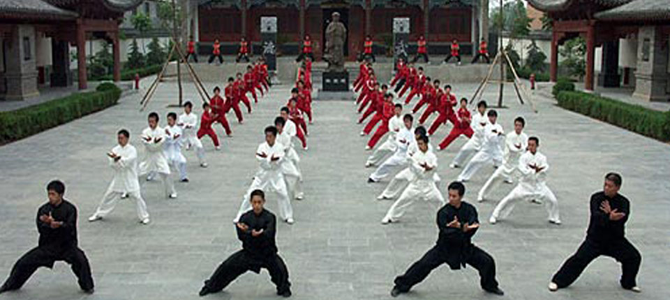靜如山岳, 動如江河 “Be still as a mountain, move like great river”
There are five major styles of Taijiquan in practice in the world today. These are the Chen, Yang, Wu, Wu (Hao), and Sun styles. Chen Style Taijiquan is the oldest and the origin of the other styles. It was created by the 9th Generation Patriarch of the Chen family, Chen Wangting (1580-1660) in the Chen family’s ancestral village of Chenjiagou, a small farming community located in Wen County of Henan Province. Chen Wangting was a garrison officer in the latter years of the Ming Dynasty and had much experience in military training and battlefield warfare. But by the end of the Ming Dynasty and the onset of the Qing Dynasty, he retired from active duty and sought refuge in Chenjiagou. It was during this time that Chen Wangting is said to have taken his family’s boxing style, his varied military experience, other boxing methods, and combined them with principles and techniques from Daoyin (internal energy manipulation), TuNa (breathing exercises), Yijing philosophy (The Book of Change), and meridian theories from Chinese medicine.
Chen Wangting’s method is said to have contained five short forms, a long form and a fast form. This was later streamlined by Chen Changxing, a 14th Generation Grandmaster and teacher of Yang Luchan (the founder of Yang Style Taijiquan). Chen Changxing combined all of the training forms into one long form, known as Old Frame Routine One (Lao Jia Yi Lu), and one fast form, known as Old Frame Routine Two (Lao Jia Er Lu). This formed the foundation of what we now recognize as Taijiquan. Several other variants of Chen Style Taijiquan have developed such as New Frame (Xin Jia), Small Frame (Xiao Jia), Zhaobao Village Style, and multiple introductory and compulsory competition forms. However they all have their basis in the Lao Jia system.
Taijiquan is characterized as a martial art that focuses on both internal and external training. This means that the physical body, it’s coordination and conditioning, the energetic vibrancy of the self, mental health, and clarity of spirit are all developed in this system. Grandmaster Chen Zhenglei, a 19th Generation Chen Family Member and 11th Generation Chen Style Taijiquan Lineage Holder, says that the style is “designed and structured according to biological principles as well as to the laws of nature. The main characteristics are continuous motions without hitches; interlaced fast and slow motions; incorporated hard and soft strengths; and relaxed, flexible, elastic and sometimes jerking moves. Taichi as a training system is supported by a set of mature and proven theories throughout the complete training processes. We can also look at taichi as a huge engineering system and the training to achieve substantial high level is definitely no easy task.”
Chen Style Taijiquan is a very sophisticated martial art that requires tremendous dedication, effort and understanding to achieve high levels of development. This is the definition of Kungfu.
Three Levels of Training
Proper training in Tai Chi Chuan (also Taijiquan) can be divided into three basic categories: basic training (jibengong), forms training (tao lu), and applications training (tuishou, qinna, shuai, sanda). Basic training includes warm ups, calisthenics, conditioning, stance training, silk reeling (chansijing), meditation, and Qigong. Qigong is an ancient practice for cultivating and balancing “qi” (intrinsic life energy) in the body. Through simple movements, breathing and visualization exercises, participants increase mindfulness, awareness, and qi flow in the body, resulting in better health and vitality. Forms are traditionally choreographed sets of movement that are designed to exercise the martial applications, body dynamics, advanced body conditioning, internal energetics, and mental discipline that is inherent in Chen Style Taijiquan. In forms training students learn barehand forms and weapons forms as they are practiced in the village of Chenjiagou, the birthplace of Tai Chi Chuan. In applications training, the student learns how to directly use all the skills of Chen Style Taijiquan in martial situations. There are many training methodologies including sparring and push hands(tuishou) but the purpose is to train the four basic combat applications of kicking (ti); striking (da); grappling, wrestling, throwing(shuai); and controlling (na) within Tai Chi principles. To have a complete knowledge of Chen StyleTaijiquan it is imperative to train in all of these areas as befits the student’s age group and abilities.
Kids Chen Taiji Kungfu
The following is a poem attributed to Chen Wangting…
Xu Huai (A Song of Remembrance) .
I sigh to think of those years, wearing armor with a lance in my hand.
We swept away countless enemies, several times in mortal danger.
I was rewarded with honors, all to no avail.
Now that I am old and short of breath, my only constant companion is the book (Huang Ting ).
When I am depressed I practice boxing routines, during the busy times I plough the fields.
In my spare time I teach my sons and grandsons, it is up to them whether or not they succeed.
It is advantageous to pay the grain tax early, it is important to pay back personal debts immediately.
Don’t be prideful and don’t flatter others, be patient and always make the first concession.
People say that I am foolish and that I am seedy, I hear this but I don’t take it to heart.
I laugh at the people and nobles fussing about anxiously, not like me keeping in good spirits and staying calm.
I don’t covet fame or profit, having been involved in affairs I understand trickery.
Happiness is to fish and to wander in the countryside, without a care for prosperity or ruin.
Suppose there was a world where peace and health prevailed, tranquility and simplicity would be commonplace.
There would be no hatred and no want.
I don’t care that others look down on poverty, I am not concerned about success or failure.
If I am not already an immortal then who is ?
~Chen Wangting

